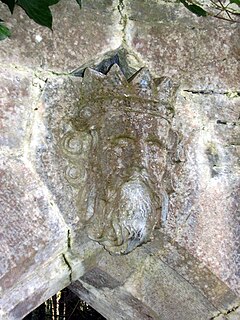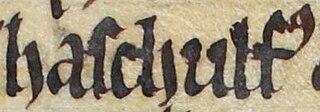| |||||
| Centuries: | |||||
|---|---|---|---|---|---|
| Decades: | |||||
| See also: | Other events of 1115 List of years in Ireland | ||||
Events from the year 1115 in Ireland.
| |||||
| Centuries: | |||||
|---|---|---|---|---|---|
| Decades: | |||||
| See also: | Other events of 1115 List of years in Ireland | ||||
Events from the year 1115 in Ireland.

Vikings invaded the territory around Dublin in the 9th century, establishing the Norse Kingdom of Dublin, the earliest and longest-lasting Norse kingdom in Ireland. Its territory corresponded to most of present-day County Dublin. The Norse referred to the kingdom as Dyflin, which is derived from Irish Dubh Linn, meaning 'black pool'. The first reference to the Vikings comes from the Annals of Ulster and the first entry for 841 AD reads: "Pagans still on Lough Neagh". It is from this date onward that historians get references to ship fortresses or longphorts being established in Ireland. It may be safe to assume that the Vikings first over-wintered in 840–841 AD. The actual location of the longphort of Dublin is still a hotly debated issue. Norse rulers of Dublin were often co-kings, and occasionally also Kings of Jórvík in what is now Yorkshire. Under their rule, Dublin became the biggest slave port in Western Europe.
Diarmait mac Énna meic Murchada was an early twelfth-century ruler of the kingdoms of Leinster and Dublin.
Domnall Gerrlámhach, also known as Domnall Gerrlámhach Ua Briain, Domnall mac Muirchertaig, and Domnall Ua Briain, was an obscure twelfth-century Uí Briain dynast and King of Dublin. He was one of two sons of Muirchertach Ua Briain, High King of Ireland. Domnall's father appears to have installed him as King of Dublin in the late eleventh- or early twelfth century, which suggests that he was his father's successor-designate. Although Domnall won a remarkable victory in the defence of the Kingdom of Dublin in the face of an invasion from the Kingdom of Leinster in 1115, he failed to achieve the successes of his father. After his final expulsion from Dublin at the hands of Toirdelbach Ua Conchobair, King of Connacht, and the death of his father, Domnall disappears from record until his own death in 1135. He was perhaps survived by two sons.
Diarmait Mac Murchada, anglicised as Dermot MacMurrough, Dermod MacMurrough, Dermot MacMorrogh or Dermot MacMorrow, was a King of Leinster in Ireland. In 1167, he was deprived of his kingdom by the High King of Ireland – Ruaidri Ua Conchobair. The grounds for the dispossession were that Mac Murchada had, in 1152, abducted Derbforgaill, the wife of the King of Breifne, Tiernan O'Rourke. To recover his kingdom, Mac Murchada solicited help from the King of England Henry II of England. His issue unresolved, he gained the military support of the Earl Richard de Clare, the 2nd Earl of Pembroke, who was in opposition to Henry II due to his support for Stephen, King of England against Henry's mother in The Anarchy. In exchange for his aid, Strongbow was married to Mac Murchada's daughter Aoife and promised succession to the Kingship of Leinster. Henry II then mounted a larger second invasion in 1171 to ensure his control over Strongbow, resulting in the Norman Lordship of Ireland. Mac Murchada was later known as Diarmait na nGall.

Ruaidrí Ua Conchobair was King of Connacht from 1156 to 1186, and High King of Ireland from 1166 to 1193. He was the last High King of Ireland before the Norman invasion.

The Kings of Ailech belonged to the Northern Uí Néill and were based at the Grianan of Aileach, a hillfort on top of Greenan Mountain in modern-day County Donegal, Republic of Ireland. The restored fort stands in a commanding position at the base of the Inishowen peninsula overlooking Lough Swilly to the west and Lough Foyle to the east.

Domhnall Ua Lochlainn, also known as Domhnall Mac Lochlainn, claimed to be High King of Ireland.
Toirdhealbhach Ua Briain, anglicised Turlough O'Brien, was King of Munster and effectively High King of Ireland. A grandson of Brian Bóruma, Toirdelbach was the son of Tadc mac Briain who was killed in 1023 by his half-brother Donnchad mac Briain.
The Kings of Uisnech were of the Uí Néill and one of its major southern branches, the Clann Cholmáin. The Hill of Uisnech is located in what is now County Westmeath, and was in early historic Ireland considered as the area where all five provinces met.
The Uí Ceinnselaig, from the Old Irish "grandsons of Cennsalach", are an Irish dynasty of Leinster who trace their descent from Énnae Cennsalach, a supposed contemporary of Niall of the Nine Hostages. Énda was said to be a grandson of Bressal Bélach and a first cousin of Dúnlaing mac Énda Niada, eponymous ancestor of the rival Uí Dúnlainge.

Ascall mac Ragnaill meic Torcaill, also known as Ascall Mac Torcaill, was the last Norse-Gaelic King of Dublin. He was a member of the Meic Torcaill, a Dublin family of significance since the early twelfth century.
Domnall Mór Ua Briain, or Domnall Mór mac Toirrdelbaig Uí Briain, was King of Thomond in Ireland from 1168 to 1194 and a claimant to the title King of Munster. He was also styled King of Limerick, a title belonging to the O'Brien dynasty since Brian Boru's annexation of the Norse city in the 10th century.
Áed Ua Conchobair or Áed in Gai Bernaig was King of Connacht, and reigned 1046–1067.
Áed in Macáem Tóinlesc or Aodh an Macaoimh Tóinleasg was a 12th-century ruler of Tulach Óc and Tír Eogain. He was the first of his family to play a significant role in the high politics of northern Ireland, following the death of the Muirchertach Mac Lochlainn king of Tír Eogain and high king of Ireland.
Events from the year 1118 in Ireland.
Donnchad mac Domnaill Remair, also known as Donnchadh mac Domhnall Reamhair, was a late-eleventh-century ruler of the kingdoms of Leinster and Dublin. He was a son of Domnall Remar mac Máel na mBó. Donnchad was slain in 1089.
Énna Mac Murchada, or Enna Mac Murchada, also known as Énna mac Donnchada, and Énna mac Donnchada mic Murchada, was a twelfth-century ruler of Uí Chennselaig, Leinster, and Dublin. Énna was a member of the Meic Murchada, a branch of the Uí Chennselaig dynasty that came to power in Leinster in the person of his paternal great-grandfather. Énna himself gained power following the death of his cousin Diarmait mac Énna. Throughout much of his reign, Énna acknowledged the overlordship of Toirdelbach Ua Conchobair, King of Connacht, although he participated in a failed revolt against the latter in 1124 before making amends. When Énna died in 1126, Toirdelbach successfully took advantage of the resulting power vacuum.
Domnall mac Murchada, also known as Domnall mac Murchada meic Diarmata, was a leading late eleventh-century claimant to the Kingdom of Leinster, and a King of Dublin. As a son of Murchad mac Diarmata, King of Dublin and the Isles, Domnall was a grandson of Diarmait mac Máel na mBó, King of Leinster, and thus a member of the Uí Chennselaig. Domnall was also the first of the Meic Murchada, a branch of the Uí Chennselaig named after his father.
Events from the year 1117 in Ireland.